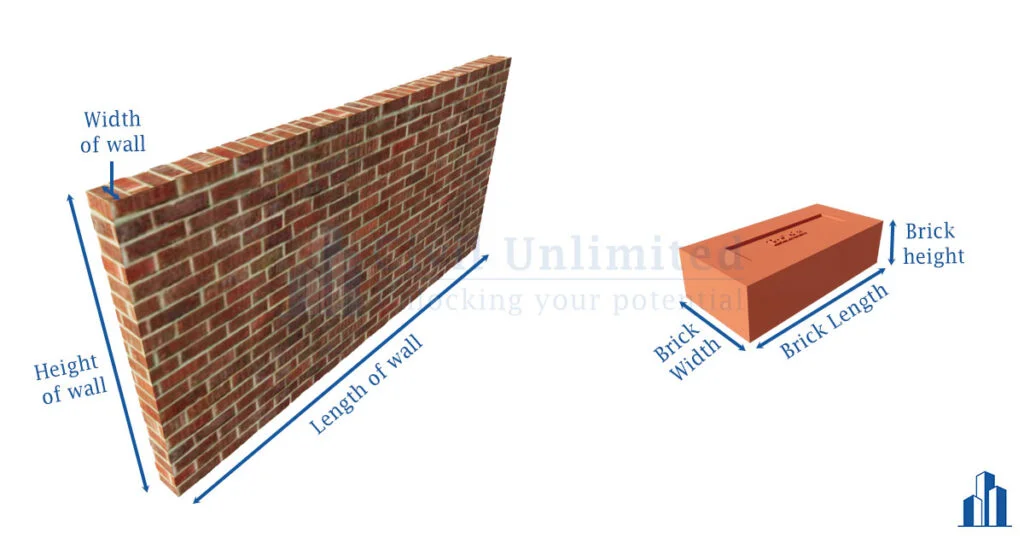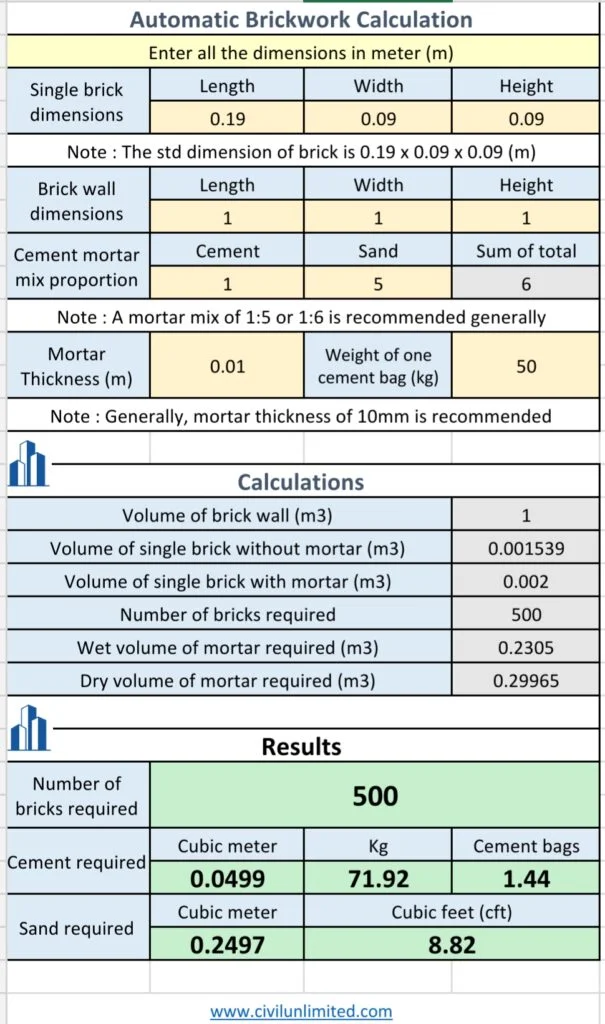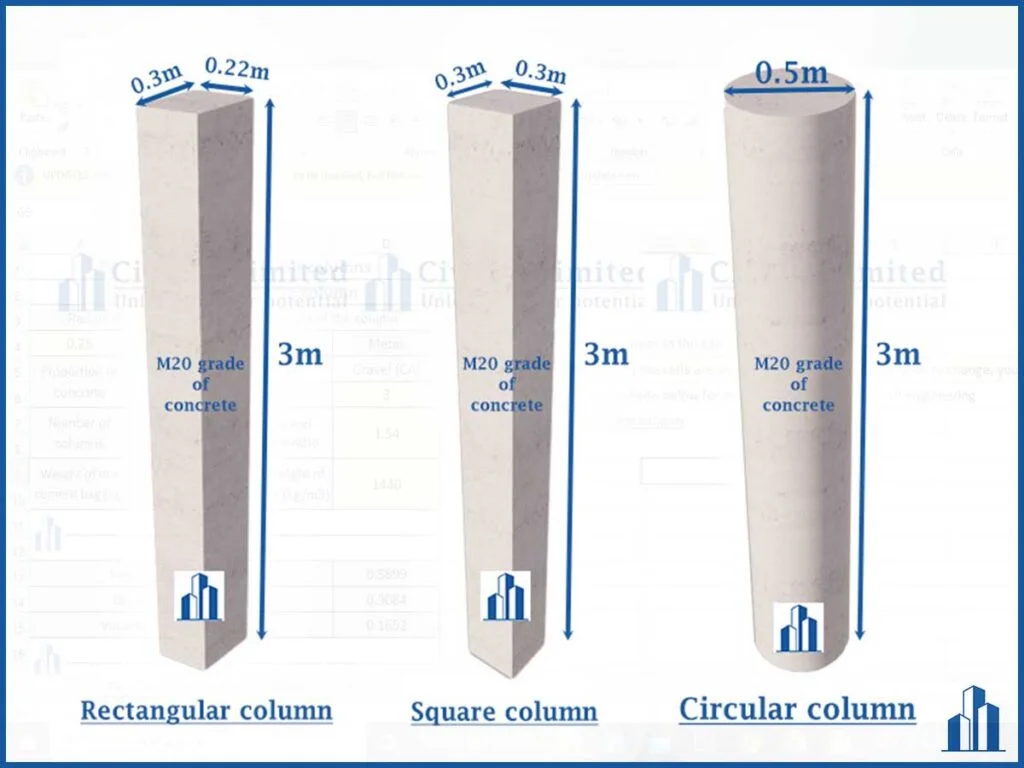Brick wall / Brickwork is nothing but masonry produced by a bricklayer, using bricks and mortar.
Mortar is a mixture of sand, cement, and water and is used in masonry construction to hold the bricks together.
If you are wondering how many bricks you needed and how much cement bag is required for constructing a brick wall, then this article is for you.
In this article, we are going to estimate the materials required in three different ways. They are,
1) Conventional method
2) Thumb rule method
3) By using an automatic calculator
Let’s discuss each of them in detail.
1) Conventional method
In this method, we are going to estimate the materials using the following steps.
Step 1: Know the dimension of the brick we are going to use in the construction. The standard dimension of the brick is 190 x 90 x 90 (mm).
Generally, for a normal brick wall, the mortar thickness of 10 mm is recommended.
Step 2: Fix the dimension of the wall you are going to build and find its volume.
In our case, Let’s assume the brick wall dimensions as 1m x 1m x 1m and the volume of the brick wall = 1*1*1 = 1m3. (m3 = cubic meter)
Step 3: Find the volume of single brick without mortar
Volume of a single brick without mortar = 0.19 x 0.09 x 0.09 = 0.001539 m3.
Step 4: Find the volume of the single brick with mortar
Volume of a single brick with mortar = 0.20 x 0.10 x 0.10 = 0.002 m3.
Step 5: Find the number of bricks required

Remember,
“The number of bricks required to build 1m3 of wall with standard dimension bricks is 500”
Step 6: Find the volume of mortar required
Total volume of brick wall = Volume of cement mortar + Volume of bricks without mortar
Volume of mortar = Total volume of brick wall – volume of bricks without mortar
Volume of mortar req. = 1 m3 – (Volume of a single brick without mortar x No. of bricks)
Volume of mortar req. = 1 m3 – (0.001539 m3 x 500)
Volume of mortar req. = 0.23 m3.
The volume we derived here is the wet volume of mortar. But we want to measure materials in their dry state. Hence to make a dry volume, add 30% extra of its volume.
Dry Volume of mortar req. = 0.23 x 1.3 = 0.30 m3.
Remember,
“The volume of cement mortar required for 1m3 of brickwork built with standard dimension brick is 0.3 m3.”
Step 7: Adopt a cement mortar mix ratio.
Various mortar mix ratios (cement: sand) such as 1:3, 1:4, 1:5, and 1:6 are generally used. Recommended mix ratio for brickwork is either 1:5 or 1:6.
Step 8: Calculation of materials required for making mortar
Here, we assume a 1:6 proportion. Then,

Volume of cement required = 0.3 m3 x (1/7) = 0.0428 m3.
To convert it into kg, multiply by the unit weight of cement which is 1440 kg/m3.
Quantity of cement required = 0.0428 x 1440 = 61.71 kg.
No. of cement bags = 61.71/50(one cement bag weight) = 1.23 bags required.
In the same way,

Volume of sand req. = 0.3 x (6/7) = 0.25 m3 = 0.25 X 35.31 = 8.82 cubic feet (cft). (1m3 = 35.31cft)
Therefore, all the materials required for 1m3 of brickwork built with standard brick are,
No. of bricks = 500
Cement required = 62 kg (~2 bags)
Sand required = 9 cft.
Add an additional 5% of these materials to compensate for the wastage.
Congratulations! You learned the whole calculation behind brickwork estimation.
But sometimes, when you are working in the field, these calculations become too tedious to process, that’s why the thumb rule method is widely used by site engineers.
2) Thumb rule method
Thumb rules are widely used by site engineers to quickly estimate the materials required for construction.
But remember this method is not so accurate compared to the conventional method since this method requires a lot of assumptions.
A lot of site engineers may modify these assumptions according to their experiences. So the assumptions may differ slightly from one person to another.
So let’s assume the size of the brick, dimensions of the wall, mortar thickness, and mortar ratio as the same as above.
Volume of brick wall = 1m x1m x1m = 1m3.
Volume of single brick without mortar = 0.19 x 0.09 x 0.09 = 0.001539 m3.
No. of bricks required = 1 m3/ 0.001539m3 = 650 bricks.
Assumption: In a brick wall, 75% of the volume is occupied by bricks and 25% of the volume is occupied by cement mortar.
As per the assumption, a 25% reduction is made from bricks
Total number of bricks required = 650 – (25% of 650) = 650 – 162 = 488 bricks.
Volume of cement mortar = 25% of the volume of wall = 0.25 x 1m3 = 0.25 m3.
Dry volume of mortar req. = 0.25 x 1.3 = 0.32 m3.
Qty of cement = 0.32 x (1/7) x 1440 = 66 Kg = 1.24 bags.
Qty of sand = 0.32 x (6/7) = 0.27 m3 = 0.27 x 35.31 = 9.5 cft.
Therefore, the materials required are,
No. of bricks = 488
Cement required = 66 kg (~2 bags)
Sand required = 9.5 cft.
Add an additional 5% of these materials to compensate for the wastage.
See there is a small variation between the conventional method and the thumb rule method because of the assumption. But this variation also can be neglected if we consider the volume of cement mortar as 23% of the volume of the wall and the remaining as brickwork.
3) By using an automatic calculator
There come times when we are in a hurry to place the order for materials (or) we want to double-check our calculations which are already done. At that time, we may use this calculator which is prepared by us.

Enter the dimensions in their respective units as mentioned. If you have dimensions in any other units, kindly convert the unit and enter in the calculator.
Disclaimer: We work hard to ensure that the results presented by our calculators are correct and accurate. However, we do not guarantee that this will be the case in all situations. Our calculators are provided for reference purposes only. Please seek professional advice before making important decisions.
If the online calculator didn’t work for you, no worries. Download this automatic brickwork excel calculator which performs the same calculations as above.

Now, as you learn all the concepts, why not try some practical problems? Click here to learn some practical examples of brickwork estimation.
Hope you understand everything you need to know about the estimation of brickworks. If you have any queries (or) if you find this article helpful, let us know in the comment section.
Read more: Laboratory tests of cement, How to read a level staff, 15 Types of cement and their Uses in the construction industry.




Very Good Work, and Very Correct Guidance about calculating The Qty. of Bricks, Cement, and sand. Thank You.
Thank you so much for your appreciation! I’m glad you found this article helpful.
The Calculations procedure is Very accurate and guidance for the civil Quantity Surveyor and Construction Workers.
Exellent.Would be very usefull for civil engineers in estimating the quantity of material in construction works of buildings and offices. All new engineers should should read it.
V N Mathur
Chief Engineer (civil)RETD
UP power Corporation Ltd
UP
Thank you for your kind words! We’re thrilled to hear that our content is proving valuable to civil engineers. Your expertise and endorsement is much appreciated.
Perfect
I have learned a lot